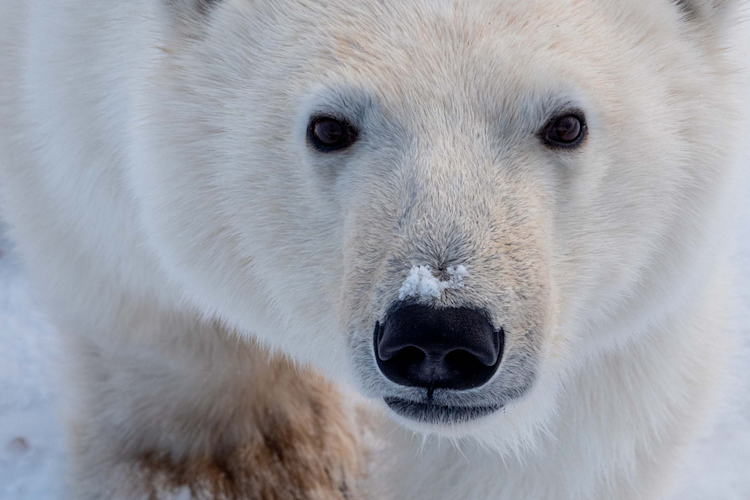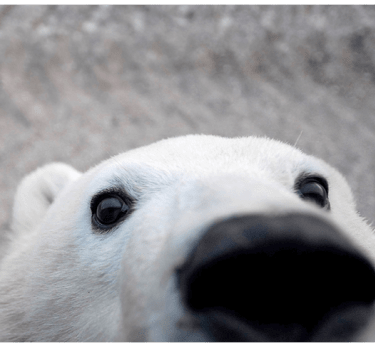Module 3C: Reflect

Photo: BJ Kirschhoffer / Polar Bears International
A Species in Decline
How do you discuss the status of polar bears?
Step One
Take a moment to explore results from a paper, released July 20, 2020 in Nature Climate Change, where scientists forecast the future of polar bear populations based on two different carbon emissions scenarios, before watching the two videos below.
When a scientist says polar bear populations are declining, this means that polar bear individuals are dying and/or not thriving. This is imagery and descriptions that no one likes to see, hear, or think about. However, if we don't talk about this, the reality of what is happening with polar bears will not be understood, which means that nothing will be done about it. It is not recommended, however, to use the same language or communication methods with the scientific community (including yourselves) as one would for communicating with the general public. Different audiences require different tactics.
The observations of a declining population: What does it really mean for polar bears if sea ice is declining? How are they impacted and what are scientists seeing?
Due to sea ice decline we have seen:
Declining growth rates, body conditions, survival, reproduction, and population size
Unusual feeding behaviour and movements
Drowning
Increased Cannibalism
Loss of access to denning areas
Population Decline as it Relates to the Ecoregions
In the first section of this module, we introduced the sea ice ecoregions. Below, you'll read about how each sea ice ecoregion is impacted by climate change, and the threats faced by the polar bears that live there.
Seasonal Ice Ecoregion – Seasonal sea ice areas occur at the southern extent of the polar bears’ range where sea ice melts each summer and the bears must wait for freeze-up in the fall until they can hunt again. This ecoregion includes places like Canada’s Hudson Bay. Polar bears in these seasonal areas are some of the most at-risk, as longer and longer ice-free seasons push the bears on land for increased periods of time, testing the limits of their fat reserves.
Polar Basin Divergent Ice Ecoregion – Divergent Ice Ecoregion – In this area, sea ice forms along the shore but is constantly diverting from shore because of ocean currents that pull the ice away This is particularly evident in summer. As the sea recedes farther and farther from shore in a warming Arctic, these polar bears are faced with a choice of coming ashore—fasting until the ice returns in the fall—or swimming long, exhausting distances to reach the remaining pack ice. Ice that's located far offshore, however, often covers unproductive parts of the sea, so bears in these areas may successfully complete a marathon swim, but still not find any seals to hunt. Polar bears that live in these areas are at great risk: from longer and longer swims, prolonged fasting periods, and encounters with humans on shore. In 2019, our chief scientist, Dr. Steven Amstrup, testified before Congress about the Arctic National Wildlife Refuge and its coastal plain—a pristine wilderness and important denning area for polar bears that is now under threat from proposed oil and gas module. Take a look for a view of how mums and cubs are faring in parts of this ice region in the video below.
Polar Basin Convergent Ice Ecoregion – Sea ice originally formed in the Divergent ecoregion is transferred via ocean currents to the shore of these habitats, providing polar bears with access to seals throughout the full year. Polar bears in these areas are believed to be currently faring well, but scientists predict that ice in these areas will disappear within 75 years—and, with it, resident polar bear subpopulations—unless action is taken to reduce CO2.
Archipelago Ice Ecoregion – Islands in the Canadian High Arctic and Greenland are far enough north that sea ice remains along the coast even in summer, providing hunting for the bears. This ecoregion is predicted to be the last stronghold for polar bears, but it, too, is expected to melt within 100 years unless greenhouse gas emissions are greatly reduced.
Step Two
Read Melting Under Pressure: The Real Scoop On Climate Warming and Polar Bears.
Guiding Questions:
What are signs of sea ice decline?
What do you find confusing about the status of polar bears?
How would you explain to someone that climate change is NOT good for polar bears?
Share a comment in the Discord community in response to one of the questions.

Photo: Mike Lockhart / Polar Bears International
Finished?
Continue on to Module 3D – Apply.

Photo: Kieran McIver / Polar Bears International











